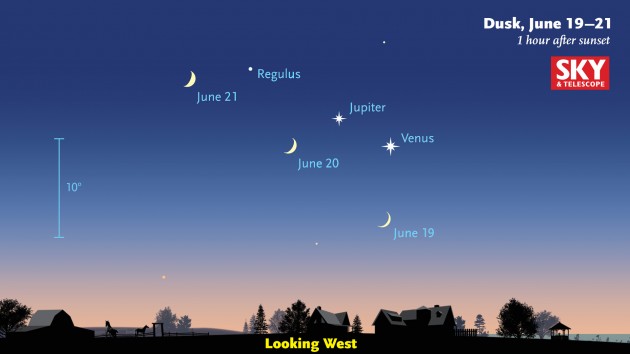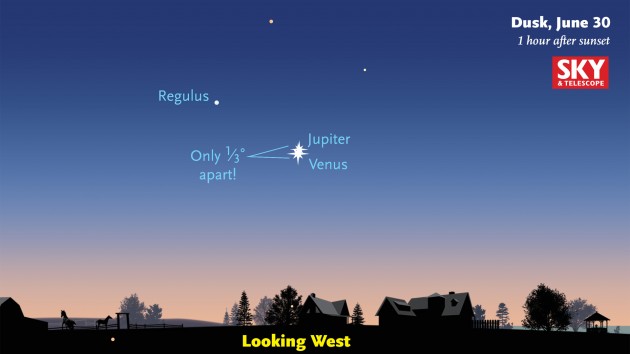Contacts:
Kelly Beatty, Senior Editor, Sky & Telescope
855-638-5388 x22168, [email protected]
Alan MacRobert, Senior Editor, Sky & Telescope
855-638-5388 x22151, [email protected]
| Note to Editors/Producers: This release is accompanied by publication-quality illustrations; see details below. |
All this month the two brightest planets, Venus and Jupiter, have been drawing closer together in the west in the evening twilight — and drawing all eyes toward them. Look west on a clear evening as dusk is fading, and you can't miss them. They're the brightest celestial objects after the Sun and Moon.
At the beginning of June, the two planets were 20° apart in the sky, about twice the width of your fist held at arm's length. Week by week, Jupiter and the stars behind it have gradually slipped lower in the evening twilight. But Venus, due to its rapid orbital motion around the Sun, has stayed high up. The resulting slow-motion convergence is setting the stage for a pair of dramatic sky sights.
** First, on the evenings of June 19th and 20th, you'll find Venus soon after sunset well up in the west. Jupiter is about 6° to its upper left and only 1⁄12 as bright. Farther to their upper left, and fainter, is Regulus, the alpha star of the constellation Leo. Adding to the scene is a thin crescent Moon: under the planets on the 19th, and left of them on the 20th. The view will be most dramatic on the 20th, when the two planets and the Moon will be bunched closely enough to cover with your fist.
Although they'll appear near one another, they're actually not. The Moon is closest to us, just 247,000 miles (400,000 km) away. Venus is 56 million miles (90 million km) from Earth, and Jupiter is 10 times farther out at just over 550 million miles (890 million km).
** A second, even more dramatic event occurs on June 30th, when Venus and Jupiter will appear so close together — just 1⁄3° apart — that they'll look like a tight, brilliant double star in the evening sky. You'll be able to cover both with the tip of an outstretched finger.
The two planets spend eight evenings within 2° of each other (about a thumb's width at arm's length) from June 27th through July 4th.
Astronomers refer to a close celestial pair-up like this as a conjunction. "Planetary conjunctions have no effect on Earth or human affairs," notes Sky & Telescope Senior Editor Alan MacRobert, "except for one: they can lift our attention away from our own little world into the enormous things beyond. That's what amateur astronomers do all the time. A spectacular conjunction like this often gets people started in the hobby. Once you start, there's no end to how far you can go."
Such close pairings of Venus and Jupiter are not particularly rare. They appeared slightly closer together (though not as high up) before dawn on August 18, 2014, and they'll be separated by about 1° before dawn on the morning of October 26th.
Sky & Telescope Contributing Editor Fred Schaaf points out that this current trio of Venus-Jupiter conjunctions closely resembles a similar series in 3-2 BC that has been suggested as the Star of Bethlehem. "As has been the case in 2014–15," Schaaf explains, "the first two conjunctions back then were extremely close, the last one separated by about 1°, all three occurred not far from Regulus, and all were similarly high up in the sky."
The pairing on June 30th is so tight that a small backyard telescope will show both planets in the same field of view, Venus appearing as a brilliant, fat crescent and Jupiter accompanied by its four largest moons. Telescopically, the two planets will appear nearly the same size — Jupiter, though much larger in reality, is also much farther away. But their globes will contrast dramatically in brightness, with Venus's crescent appearing dazzlingly white compared to Jupiter's duller, striped cloud deck.
Sky & Telescope is making publication-quality illustrations available to our colleagues in the news media. Permission is granted for one-time, nonexclusive use in print and broadcast media, as long as appropriate credit (as noted in the caption) is included. Web publication must include a link to www.SkyandTelescope.com.

Sky & Telescope diagram

Sky & Telescope diagram
For skywatching information and astronomy news, visit SkyandTelescope.com or pick up Sky & Telescope, the essential guide to astronomy, with subscribers in more than 100 nations. Sky & Telescope and SkyandTelescope.com are divisions of F+W, a content + ecommerce company. F+W also publishes two annuals (SkyWatch and Beautiful Universe) as well as books, star atlases, posters, prints, globes, apps, and other fine astronomy products.
 0
0
Comments
You must be logged in to post a comment.